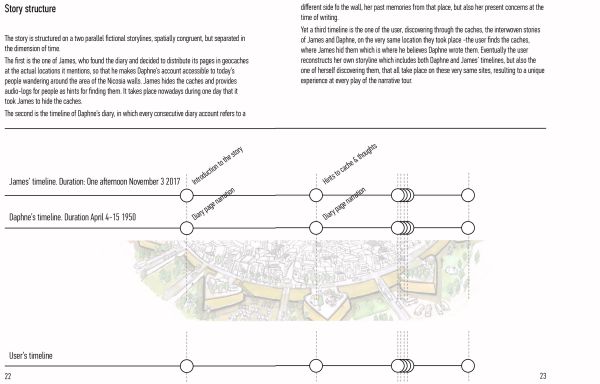Georgios ARTOPOULOS1 | Constantinos MILTIADIS2
(1The Cyprus Institute , Nicosia, Cyprus / 2TU Graz, Austria)
Keywords: intangible cultural heritage, audio-enabled routes, locative media, spatially-distributed narratives
Abstract:
This paper presents theoretical and practical considerations regarding the role of moat of the medieval walls of historic Nicosia, the last divided capital of Europe. The moat acquired an important role for Nicosia when the city started expanding beyond the medieval footprint of the labyrinthine urban fabric of the historic core during the late period of British rule on the island. After the war of 1974 and the division of Nicosia, the urgent and ever-growing needs of the city for empty plots to support its infrastructure and operation led to the fragmentation of the moat.
In response to this need it discusses new approaches to the use of Information Communication Technologies (ICT) for facilitating the re-appropriation of the moat from being used as parking space, and other fragmentary private uses, into a green belt that highlights the only shared heritage that unites the two sides of the divided city, that is, its Medieval Walls. In particular an ICT-enabled initiative is presented that involves the creation of spatially-distributed storytelling for the promotion of the history of the Medieval walls of the city by exploiting the software and communities of Geocaching driven by preliminary results of a survey of users of the public space of the moat. The organization of this initiative was supported by a H2020 COST Action (TU1306) Short Term Scientific Mission, the results of which will be presented in the paper.
Concluding, the paper presents a grassroots approach to the application of digital interfaces, which contributes to the exploitation of heritage in Mediterranean cities for the reactivation of neglected urban green spaces through playful engagement and storytelling. Employing a format of locative, historically corroborated dramatized audio narratives, this initiative intends to provide an experiential approach to history, eventually aiming to trigger the audience’s visual imaginary over their immediate surroundings.
Relevance for the conference: The paper suggests the use of a “cloud” layer over the city, on which to collect and expose the multiple narratives of its dense historical past, functioning therefore as a neutral ground for the analysis of the city’s historical palimpsest.
Relevance for the session: Employing a format of locative, historically corroborated dramatized audio narratives, the initiative intends to provide an experiential approach to history, eventually aiming to trigger the audience’s visual imaginary over their immediate surroundings.
Innovation: The paper presents a grassroots approach to the application of digital interfaces and historic narratives, which contributes to the exploitation of heritage in Mediterranean cities for the reactivation of neglected urban green spaces through storytelling.
References:
• Lyotard, J.-F. (1984). The Postmodern Condition: A Report on Knowledge. Manchester: Manchester University Press; Friedman, T. (1998).
• Civilization and Its Discontents: Simulation, Subjectivity, and Space. Game-Research (online). http://game-research.com/index.php/articles/civilization-and-its-discontents-simulation-subjectivity-and-space/.



